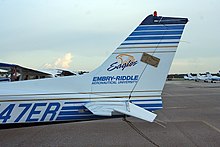Gust lock
This article needs additional citations for verification. (July 2022) |

A gust lock on an aircraft is a mechanism that locks control surfaces and keeps open aircraft doors in place while the aircraft is parked on the ground and non-operational. Gust locks prevent wind from causing unexpected movements of the control surfaces and their linked controls inside the aircraft, as well as aircraft doors on some aircraft; otherwise, wind gusts could cause possible damage to the control surfaces and systems, or to nearby people, cargo, or machinery. Some gust locks are external devices attached directly to the aircraft's control surfaces, while others are attached to the relevant flight controls inside the cockpit.
Safety
A gust lock can pose a serious safety hazard if it is not disengaged before an aircraft's takeoff, because it renders the flight control inoperative. Many internal gust locks have a safety feature that locks out the aircraft's throttle or engine-start controls until removed and stowed. External-only gust locks typically lack this safety feature, and must be tagged with a large red remove before flight streamer.

The first
A C-124 transport carrying US servicemen home for Christmas crashed in 1952 due to engagement of gust locks.
Dan-Air Flight 0034, a Hawker Siddeley 748 series 1 (registration G-BEKF) operating an oil industry support flight crashed on July 31, 1979 at Sumburgh Airport in the Shetland Islands. The aircraft failed to become airborne, ran through the perimeter fence, and crashed into the sea. The accident was due to the elevator gust lock having become re-engaged, preventing the aircraft from rotating into a flying attitude. The aircraft was destroyed and 17 of the 47 people on board drowned.
On August 27, 1992, at
On May 31, 2014, a gust lock left in place caused the crash of a Gulfstream IV at Hanscom Field, killing Philadelphia Inquirer co-owner Lewis Katz as well as six others.[4]
On July 24, 2021, in Lewiston, Idaho, former Naval Aviator and F-14 Tomcat pilot Dale Snodgrass was killed when the plane he was piloting crashed due to loss of control on takeoff caused by the gust lock not being removed before the flight.[5]
See also
- Remove before flight
- Lists of aviation topics
- List of aviation, avionics, aerospace and aeronautical abbreviations
References
- ISBN 9780764359552.
- ^ "ASN Aircraft accident de Havilland Canada DHC-4T Caribou N400NC Gimli Airport, MB (YGM)".
- ^ "Tech Support Forum".
- ^ "NTSB: Pilots left wing controls locked in place in Gulfstream crash that killed 7". USA Today.
- ^ "CAROL Query: investigations July 2021". Data.ntsb.gov. Retrieved 2022-08-19. [not specific enough to verify]
"Gust lock". The Illustrated Encyclopedia of Aviation and Space. Vol. 6. Los Angeles: A.F.E. Press. 1971. p. 1043.
External links
 Media related to Gust locks at Wikimedia Commons
Media related to Gust locks at Wikimedia Commons
